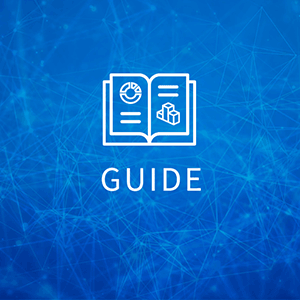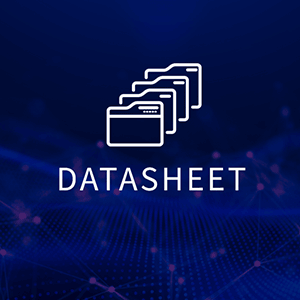The FinOps Framework, like all other frameworks, is dynamic and continually evolving. Reflecting on the emergence of DevOps years ago, I recall how seminal works like The Phoenix Project and The DevOps Handbook laid the foundation for effective DevOps practices. Over time, DevOps has grown and adapted, embracing new methodologies, technologies, architectural trends and innovations.
Developments in cloud computing, serverless architectures, containerization, automation, security, observability and more recently artificial intelligence (AI), have all significantly enriched the framework. This continuous evolution is beneficial for everyone involved.
FinOps is following the same trend
The same evolutionary trend observed in DevOps is now unfolding in the world of FinOps. Initially focused solely on cloud cost management, FinOps is now expanding to incorporate broader aspects, including the well-established disciplines of IT asset management (ITAM) and software asset management (SAM), which are meant to be part of the FinOps Framework for 2024.
This trend is not only observable in industry practices but is also supported by insights from leading research firms. Gartner, for instance, forecasts that half of all organizations will integrate FinOps and SAM into a cohesive and unified discipline by 2025.
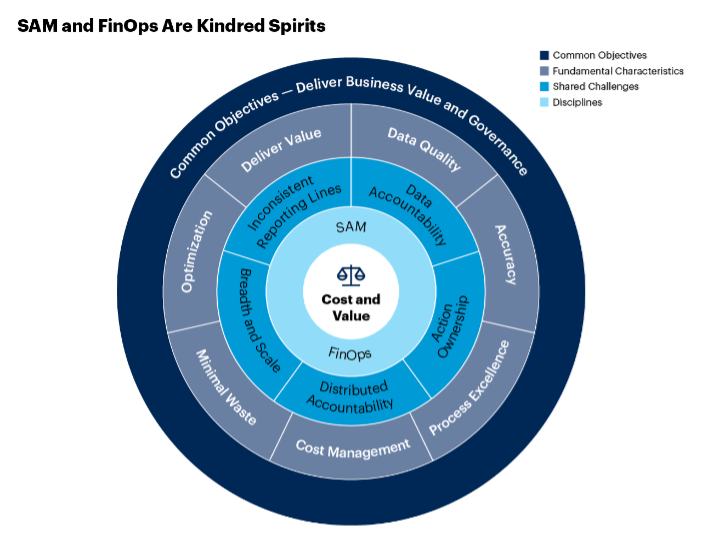
Gartner, Target Software and Cloud Costs by Uniting Software Asset Management and FinOps, Stephen White, Yoann Bianic, Stewart Buchanan, 6 April 2023
This expansion is logical and timely. In today’s versatile tech landscape, software deployment can occur virtually anywhere, encompassing on-premises data centers, cloud environments and software as a service (SaaS) models. This ubiquity simplifies decision-making processes. There’s no need for exhaustive searches for outlier cases. For instance, simply provisioning a Windows SQL Server on Azure, or deploying an Oracle database on an AWS EC2 instance, involves navigating and complying with specific software licensing terms. In many instances, the cost of commercial software licensing can significantly exceed the expenses of the underlying infrastructure.
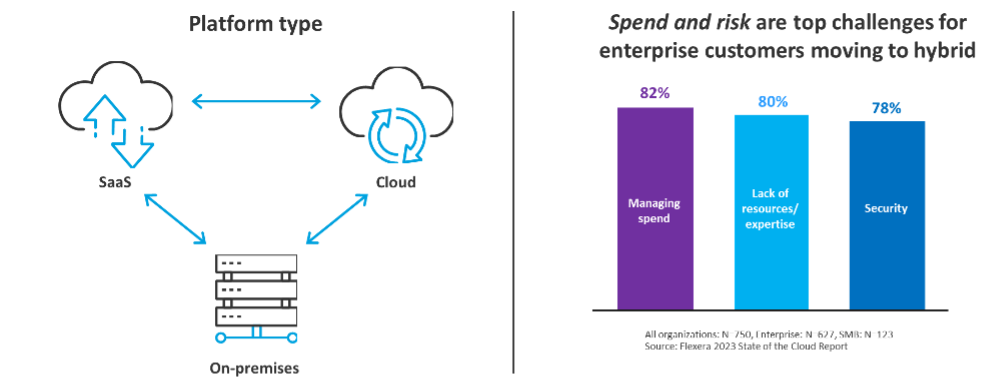
Today, my focus is specifically on the SaaS domain and illustrating its seamless alignment with the FinOps Framework. Let’s start by defining SaaS. The interpretation of SaaS can vary depending on whom you ask. Does it refer to software acquired through cloud marketplaces, known as cloud SaaS? Or does it involve vendors like Snowflake, which could be categorized as SaaS PaaS? Or are we talking about traditional SaaS models like Microsoft 365 (M365)? Regardless of the specific type, the underlying principle remains the same: all SaaS varieties represent software that incurs costs and necessitates effective management.
Before diving deeper, let’s explore some key market insights regarding SaaS. Gartner projects that SaaS spending will hit $210 billion by 2025, accounting for 50% of total enterprise application expenditures. Complementing this, the Flexera State of the ITAM Report highlights that 32% of SaaS spending is either underutilized or goes completely unused. In simple terms, this represents a staggering $70 billion.
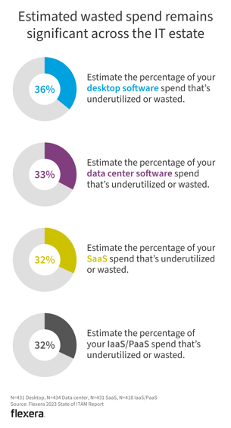
So, what can we do? The first course of action involves integrating SaaS activities within the FinOps lifecycle. The diagram provided below showcases a blend of core FinOps capabilities seamlessly intertwined with the focal point of our discussion, SaaS management capabilities. This visual representation illustrates how these two domains complement and enhance each other.
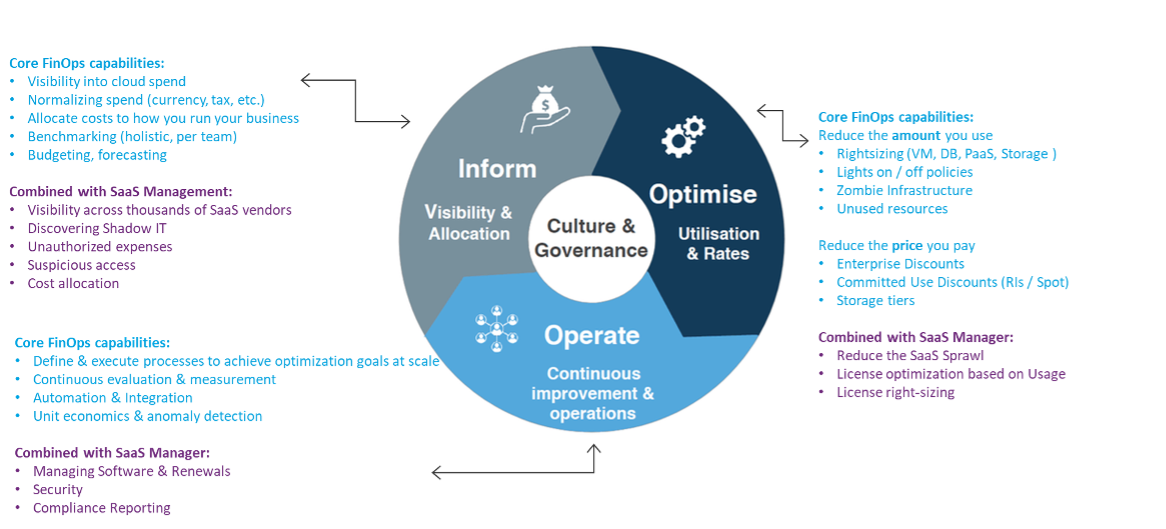
Source: FinOps Foundation
Inform phase with SaaS management
Quoting the FinOps Foundation, “this is the first phase in the FinOps journey, empowering organizations and teams with visibility, allocation, benchmarking, budgeting, and forecasting.” When we turn our attention to the SaaS market, the complexity becomes evident with the presence of approximately 30,000 distinct SaaS vendors. The diversity of this vast vendor ecosystem adds further complexity, depending on the purchasing route: whether you’re buying directly from the vendor, through a cloud marketplace, or deploying a platform as a service (PaaS) to be used as a SaaS solution. Each of these purchase methods brings its own set of challenges and considerations.
This raises a critical question: How can one achieve visibility and control over such a vast array of vendors? In the realm of cloud computing, this process seems more straightforward, as services are typically consolidated under major cloud service providers like AWS, Azure or GCP. However, the challenge intensifies when faced with the task of managing 30,000 different vendors. Most advanced SAM teams recognize that dealing with new environments (SaaS, cloud, containers) is the top challenge.
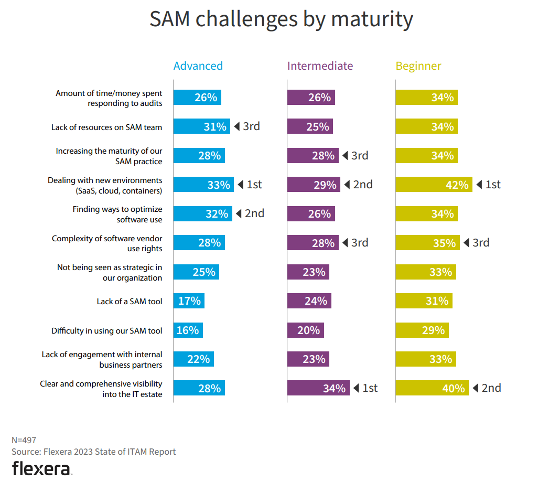
Visibility
Realistically, no company is juggling all those vendors simultaneously. However, even managing a significant handful of them can be overwhelming. Major market players like ServiceNow, Salesforce or Microsoft often constitute a substantial portion of SaaS spending for many organizations. Therefore, a strategic focus on these key players can be a wise approach. By leveraging the right insights and expertise, significant cost savings can be achieved to free up considerable financial resources.
Discovering shadow IT, unauthorized expenses and suspicious activities
In the SaaS world, shadow IT can be considered as any SaaS application used by an employee or department within an organization without explicit approval or oversight from the IT department. Just as in cloud computing, where employees can effortlessly deploy services with or without authorization, the SaaS environment also enables easy access to applications, often bypassing formal approval processes, incurring shadow IT and/or unauthorized expenses.
The offboarding process for employees is generally straightforward in on-premises and cloud environments thanks to integration with systems like Active Directory. However, the challenge intensifies with SaaS applications, especially those not integrated with Active Directory. Research indicates that about 20% of departing employees retain access to some SaaS applications, posing significant risks of data leaks and exposure of sensitive intellectual property or company know-how.
Cost allocation
A critical aspect of FinOps is the effective implementation of showback and chargeback processes. By assigning SaaS costs to specific business units, accountability extends beyond just cloud expenses to include SaaS spending as well. This allocation makes business units responsible for their respective costs, promoting more mindful and efficient use of resources. Effective cost allocation brings you closer to achieving a comprehensive understanding of total cost of ownership (TCO).
The FinOps Foundation provides guidelines for measuring progress using unit economics. Practitioners at the initial “crawl” stage primarily focus on managing cloud costs. However, as they advance to the “walk” and “run” stages, their efforts expand to encompass more complex environments. This progression involves moving beyond mere cloud cost accounting to include SaaS, hybrid infrastructure costs, licensing fees and even human capital expenses. By incorporating these diverse cost factors, organizations can achieve a comprehensive understanding of their total expenses. This approach enables them to report not only on technical metrics but also business metrics, effectively bridging the gap between business operations and technological investment.
Optimize phase with SaaS management
Echoing the FinOps Foundation, “After empowering organizations and teams, the next step is optimizing their cloud footprint, with cloud providers offering multiple optimization levers.” In the realm of SaaS, we can apply similar techniques as those used in FinOps. This includes strategies like paying less for the services through methods such as reservations or optimizing by reducing the volume of services currently in use.
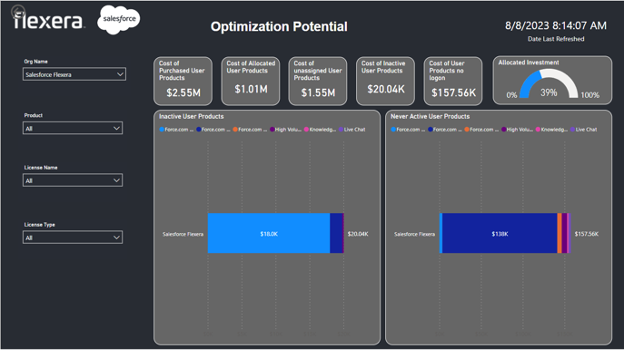
Flexera SaaS Manager PowerBI dashboard for Salesforce.
License sprawl
Let’s discuss a prevalent situation in both SaaS and on-premises environments, but less apparent in the cloud: software sprawl. This occurs when an organization uses multiple applications for the same purpose. For example, if your organization is utilizing Jira, Asana, Trello, Monday.com and Microsoft Project simultaneously for activity management, it’s worth questioning the necessity of all these vendors. This multiplicity adds layers of complexity to an already intricate hybrid IT environment. By tackling software sprawl, you can significantly streamline and consolidate your resources.
License rightsizing
That’s correct. Some vendors do allow you to rightsize your licenses. For instance, an organization might find that many users are subscribed to a premium Microsoft 365 plan, yet only use features available in a more basic tier. This situation is also seen with ServiceNow and Salesforce, where there’s a possibility of paying for services or features that aren’t actively used. In such cases, adjusting the licenses to more suitable tiers can lead to significant cost savings.
Comparatively, rightsizing can also be reasonably straightforward in the cloud environment. By setting thresholds around CPU and memory, understanding usage trends and considering the business context, organizations can quickly identify opportunities for optimization. In the SaaS realm, the process is often more complex. This complexity arises from the intricate licensing models of SaaS providers, combined with the challenge of acquiring accurate data and insights necessary for informed decision making.
License optimization based on usage
License optimization based on usage is arguably the most effective method for reducing wasteful SaaS spending. By closely monitoring user activities, organizations can gain insights into who is using which services and how frequently. This information allows for the adjustment of SaaS subscription plans to align to actual usage, thereby avoiding unnecessary expenses.
Operate phase with SaaS management
Following the same approach as the previous phases, let’s see a short definition from the FinOps Foundation on the Operate phase: “Organizations start to continuously evaluate business objectives and the metrics they are tracking against those objectives, and how they are trending.”
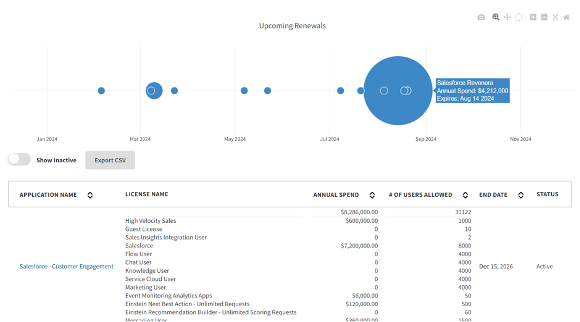
In the SaaS domain, establishing key metrics—as discussed throughout this article—is vital. With proper visibility, an organization can set its team up to negotiate better prices in upcoming renewal conversations. This is achievable by utilizing accurate data gathered during the Inform phase.
Additionally, it enables the security team to quickly identify and respond to any suspicious activities, potentially preventing data leaks.
Cloud Management
Take control of cloud use with out-of-the-box and customized policies to automate cost governance, operations, security and compliance.
SaaS and FinOps thrive together
Integrating SaaS management with the FinOps Framework is a logical and effective strategy. By applying best practices from both FinOps and Software Asset Management, you can elevate your organization’s FinOps practices to new heights of efficiency and effectiveness.
In this discussion we’ve concentrated on the intersection of SaaS and FinOps, but it’s important to also consider on-premises solutions. At Flexera, our goal is to maximize the value of your technology investments regardless of where they are deployed, from on-premises environments to cloud and SaaS platforms. We are committed to ensuring the highest return on investment across all technology landscapes.
Learn more about Flexera One FinOps.





